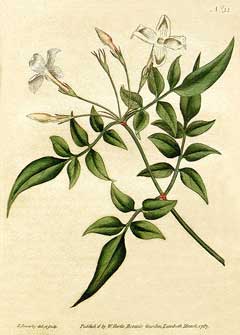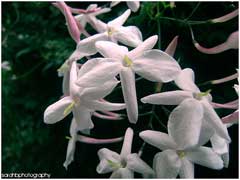 |
|
|
 |
| http://www.flickr.com/photos/25816788@N08/2855534398 |
Translate this page:
Summary
Physical Characteristics

 Jasminum_officinale is a deciduous Climber growing to 10 m (32ft) by 10 m (32ft) at a fast rate.
Jasminum_officinale is a deciduous Climber growing to 10 m (32ft) by 10 m (32ft) at a fast rate.
See above for USDA hardiness. It is hardy to UK zone 7. It is in flower from June to September. The species is hermaphrodite (has both male and female organs) and is pollinated by Insects.
Suitable for: light (sandy), medium (loamy) and heavy (clay) soils and prefers well-drained soil. Suitable pH: mildly acid, neutral and basic (mildly alkaline) soils. It can grow in semi-shade (light woodland) or no shade. It prefers moist soil.
UK Hardiness Map
US Hardiness Map
Synonyms
Plant Habitats
Edible Uses
Flowers - fragrant. Eaten or used to flavour or scent tea[183]. The dried flowers are a tea substitute[177]. An essential oil from the flowers is used as a condiment in various foods, especially Maraschino cherries but also baked goods, ice cream, sweets, chewing gum etc[183, 238]. It imparts a bitter-sweet floral tone[183].
References More on Edible Uses
Medicinal Uses
Plants For A Future can not take any responsibility for any adverse effects from the use of plants. Always seek advice from a professional before using a plant medicinally.
The leaf juice is applied to corns and ear discharges[218, 240]. The leaves contain salicylic acid (found also in the bark of Salix species and used as an analgesic, febrifuge etc)[218, 240]. The root is used in the treatment of ringworm[240]. The flowers are aphrodisiac, antiseptic, antispasmodic, galactogogue and tonic[178, 218, 238]. They are mainly used in aromatherapy (see below). The essential oil is used in aromatherapy. Its keyword is 'Aphrodisiac'[210]. It is used in the treatment of depression, nervous tension, impotence, frigidity, menstrual disorders and weak digestion[238].
References More on Medicinal Uses
The Bookshop: Edible Plant Books
Our Latest books on Perennial Plants For Food Forests and Permaculture Gardens in paperback or digital formats.

Edible Tropical Plants
Food Forest Plants for Hotter Conditions: 250+ Plants For Tropical Food Forests & Permaculture Gardens.
More

Edible Temperate Plants
Plants for Your Food Forest: 500 Plants for Temperate Food Forests & Permaculture Gardens.
More

More Books
PFAF have eight books available in paperback and digital formats. Browse the shop for more information.
Shop Now
Other Uses
An essential oil from the flowers is used in perfumery[46, 171, 200]. The flowers are picked soon after opening each morning and used fresh for oil extraction[238].
Special Uses
References More on Other Uses
Cultivation details
Succeeds in a good well-drained loam[200], preferring a sunny position[182]. Very shade tolerant, it succeeds on a north facing wall[200]. Plants are hardy to about -15°c[184]. They require the protection of a wall in northern Britain but are fully hardy in the south[11]. Another report says that they are hardy to about -10°c, and that the stem tips are often killed back in the winter though the plant soon recovers[202]. Climbs by means of twining[182]. It is self-supporting[200] and fast-growing[202]. Any pruning is best carried out in late winter and early spring[202]. A very ornamental plant[1], there are some named varieties[200]. The flowers are very fragrant[202] and the plant is sometimes cultivated for the essential oil in its flowers, the sub-species J. officinale grandiflorum (L.)Kobuski. is used[171]. Flowers are produced on the current year's growth and also on older wood[202]. Plants in this genus are notably resistant to honey fungus[200].
References Carbon Farming Information and Carbon Sequestration Information
Temperature Converter
Type a value in the Celsius field to convert the value to Fahrenheit:
Fahrenheit:
The PFAF Bookshop
Plants For A Future have a number of books available in paperback and digital form. Book titles include Edible Plants, Edible Perennials, Edible Trees,Edible Shrubs, Woodland Gardening, and Temperate Food Forest Plants. Our new book is Food Forest Plants For Hotter Conditions (Tropical and Sub-Tropical).
Shop Now
Plant Propagation
Seed - best sown as soon as it is ripe in a cold frame. When they are large enough to handle, prick the seedlings out into individual pots and grow them on in the greenhouse for at least their first winter. Plant them out into their permanent positions in late spring or early summer, after the last expected frosts. Cuttings of half-ripe wood, July/August in a frame. Very easy. Cuttings of mature wood in November. Layering.
Other Names
If available other names are mentioned here
Native Range
TEMPERATE ASIA: Afghanistan (east), Iran (north), Turkey, Georgia, Tajikistan, China (Guizhou Sheng (southwest), Sichuan Sheng, Xizang Zizhiqu, Yunnan Sheng) TROPICAL ASIA: Bhutan, India (north), Nepal, Pakistan
Weed Potential
Right plant wrong place. We are currently updating this section.
Please note that a plant may be invasive in one area but may not in your area so it’s worth checking.
Conservation Status
IUCN Red List of Threatened Plants Status :

Growth: S = slow M = medium F = fast. Soil: L = light (sandy) M = medium H = heavy (clay). pH: A = acid N = neutral B = basic (alkaline). Shade: F = full shade S = semi-shade N = no shade. Moisture: D = dry M = Moist We = wet Wa = water.
Expert comment
Author
L.
Botanical References
11200266
Links / References
For a list of references used on this page please go here
Readers comment
© 2010, Plants For A Future. Plants For A Future is a charitable company limited by guarantee, registered in England and Wales. Charity No. 1057719, Company No. 3204567.